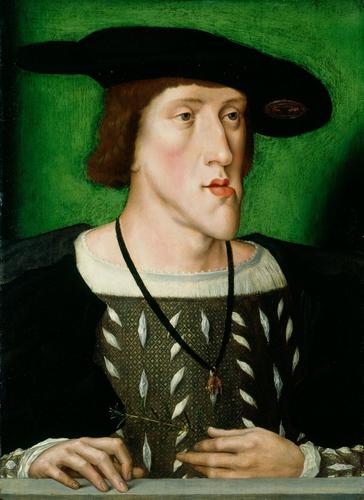-
1 of 253523 objects
Emperor Charles V (1500-58) c. 1514-16
Oil on panel | 43.8 x 32.2 cm (support, canvas/panel/stretcher external) | RCIN 403439
-
The son of Philip the Handsome and Joanna the Mad, Charles V was born in Ghent and raised in Mechelen (Malines) by his aunt, Margaret of Austria. At the age of 6 he succeeded his father as ruler of the Low Countries, although Margaret acted as regent until 1515. He succeeded his maternal grandfather in 1516 as King of Spain and in 1519 became Holy Roman Emperor on the death of his paternal grandfather, Maximilian I. He was identifiable by his dramatically undershot lower jaw, known as the ‘Habsburg lip’. This unsightly quality serves only to make the physical impression of this ruler more powerful - the combination of the strong jaw and steady gaze of the Emperor render this a commanding image.
Charles V is depicted wearing the symbol of the Order of the Golden Fleece, in this instance hanging simply from a black ribbon around his neck. Although it was popular to do otherwise, members of the Order were not officially allowed to wear the symbol without a full collar until the rules were changed in 1516. His hat is adorned with a badge of the Virgin Mary and the discernible part of the Latin inscription reads SANCTA MARIA ORA PRO NOBIS (‘Holy Mary, pray for us’). On the badge the Virgin is shown clothed in the sun; imagery taken from the Book of Revelation (12:1). Charles V is positioned in front of a parapet, creating the illusion that the fictive space of the portrait is only separated from reality by a low stone wall.
The sitter delicately holds a sprig of rosemary in his left hand. Often used as a symbol of remembrance, as spoken by Ophelia’s in Shakespeare’s Hamlet, rosemary also symbolises love and friendship. In Greek mythology rosemary was dedicated to Aphrodite, the goddess of love and fertility. As such its inclusion in this portrait may indicate that the image was created for a prospective bride. In 1514 the adolescent Charles V was betrothed to Henry VIII’s sister Mary. A letter of 30 June 1514 mentions a portrait of Charles that had been sent to Mary ‘where he is very badly depicted’ (où il est tres mal contrefait), which may relate to this portrait.
The painting appears in Pyne's illustrated 'Royal Residences' of 1819, hanging in The Old Drawing Room at Kensington Palace (RCIN 922153).
Catalogue entry adapted from Bruegel to Rubens: Masters of Flemish Painting, London, 2007Provenance
First recorded in the collection of Henry VIII at Whitehall in 1542 (no 764); in the Privy Gallery in 1639 (no 13) as the Emperor Maximilian; sold for £1 as a portrait of Maximilian to Edmund Harrison and others on 23 October 1651 from Hampton Court (no 218); recovered at the Restoration and back in the King's Privy Gallery at Whitehall in 1666 (no 119)
-
Medium and techniques
Oil on panel
Measurements
43.8 x 32.2 cm (support, canvas/panel/stretcher external)
57.5 x 45.5 cm (frame, external)
Category
Object type(s)
Other number(s)
Alternative title(s)
Maximilian I, previously called
Charles VIII of France, previously called
